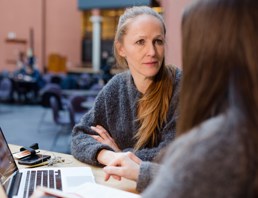Researcher calls for a new, sustainable normal after the pandemic
-
Sist oppdatert
9. november 2021
-
Kategori
-
Tema
- Sustainability
Two sides of the same problem: social and environmental sustainability must be tackled as one, maintains researcher Beniamino Callegari.
KNOWLEDGE @ KRISTIANIA: Sustainability
The ongoing COVID-19 pandemic has revealed how fragile our global development trajectory really is. While researchers, activists and public figures have tried to focus the attention on the critical environmental risks associated with unconstrained economic growth for decades, it took a global breakdown to shake the status quo.
After two years of pandemic-related loss, fear and lockdowns, we are all eager to go back to normal times, to our career and our routines.
But it must be a new normal, if we want to prevent much bigger disruptions down the road. We need to find a way to properly take into account our environmental, social and demographic limits, if we want to ensure that the normal times are here to stay.
The Earth4 model
The great challenge of the present is not to restore the previous trajectory of development after COVID-19, but to build a new one. And this is the challenge that our Earth4 project aims to help with. Connecting researchers active in different fields from all over Europe, the project aims to deliver the most ambitious sustainable development model ever created.
We will combine environmental, social, demographic and economic trends, in order to develop a complex system dynamics model. This model will integrate both economic and environmental mechanisms for the creation, implementation and monitoring of ambitious policies supporting new, resilient growth trajectories.
Available to the general public
Policy-makers, however, are not the only planned beneficiaries. Earth4 will be made available to the general public, through a dedicated platform being developed by the Club of Rome. This club is a non-governmental organization (NGO) working since 1968 to promote environmental awareness at all societal levels, to enable everyone to engage with the issues at stake, and to monitor both global and local trends.

Read also (In Norwegian)
This will measure the variety of socioeconomic and biological dimensions of current policies, aimed at comparing national efforts with what it would take to enact the global shift that we need.
The model detects unsustainable development trajectories
While the Earth4 model is not ready yet, the latest iterations already illustrate some key dynamics with perfect clarity.
For years now, the awareness that environmental and social sustainability are one and the same. The Earth4 model is able to show their complex relations, illustrating how current development trajectories lead to both unsustainable environmental footprint and unsustainable debt ratios at the global level.
Furthermore, it shows that policies aimed exclusively towards one side of the sustainability challenge, aggravate the other side, thus being ultimately self-defeating, as social collapse makes environmental progress impossible, and vice versa.
Environmental limits and distributional inequality
Cancelling or easing debts just accelerate unsustainable consumption and demographic patterns. Vice versa, imposing a qualitative shift towards green production and consumption makes existing debt loads impossible to bear, precipitating social upheaval.

Read also (In Norwegian)
Earth4 shows that a holistic approach is not only desirable, but also the only desirable approach, under current conditions. Many solutions are possible. But all solutions must tackle both the environmental limits and the distributional inequality.
Just an instrument, not an end
To achieve this, academic research is insufficient. While the Earth4 team is looking forward to developing the best possible model integrating both socioeconomic and environmental mechanisms, the model in itself is just an instrument, not an end.
The aim is to help activists, policy makers and the concerned public with the crucial political task of selecting, promoting, implementing and defending the policies we need to ensure that the new normal is here to stay.
To this end, we plan to diffuse the Earth4 model, indicators, concepts and ideas as far and wide
support the thousands of people that are already working, every day, in the same direction.
Build a new normal
Earth4 may look ambitious, but its complexity is just a pale reflection of the real issues that we are facing today. We need complex instruments to tackle complex problems. But the root of the solution is much simpler: get engaged. We all want a new normal after COVID-19. We need to realize, however, that the new normal will not be delivered to us: we need to build it.
Reference:
Collste, D., Randers, J., Goluke, U., Stoknes, P. E., Cornell, S., & Rockström, J. (2018). The Empirical Bases for the Earth3 Model: Technical Notes on the Sustainable Development Goals and Planetary Boundaries.
Greaker, M., Stoknes, P. E., Alfsen, K. H., & Ericson, T. (2013). A Kantian approach to sustainable development indicators for climate change. Ecological Economics, 91, 10-18.
Randers, J., Rockström, J., Stoknes, P. E., Goluke, U., Collste, D., Cornell, S. E., & Donges, J. (2019). Achieving the 17 Sustainable Development Goals within 9 planetary boundaries. Global Sustainability, 2.
Text: Beniamino Callegari, Researcher at School of Economics, Innovation and Technology, Kristiania University College.
We love hearing from you:
Send your comments and questions regarding this article by E-mail to kunnskap@kristiania.no.
Les også nederst

Hvordan få selgere til å bli best på bærekraft
Posisjonen «Best på bærekraft» er ledig i mange bransjer. Hva kan bedrifter gjøre for å integrere bærekraft inn i salgsfunksjonen?Les mer
Smarte kontrakter kan hjelpe forbrukerne til å ta bærekraftige valg
Smarte kontrakter er veien til grønnere og mer lønnsomme forsyningskjeder. Det vil hjelpe både handelen og forbrukerne til å ta bærekraftige valg.Les mer

